Support behaviour of children and young people.
VerifiedAdded on 2022/08/08
|8
|3096
|67
AI Summary
childcare
Contribute Materials
Your contribution can guide someone’s learning journey. Share your
documents today.
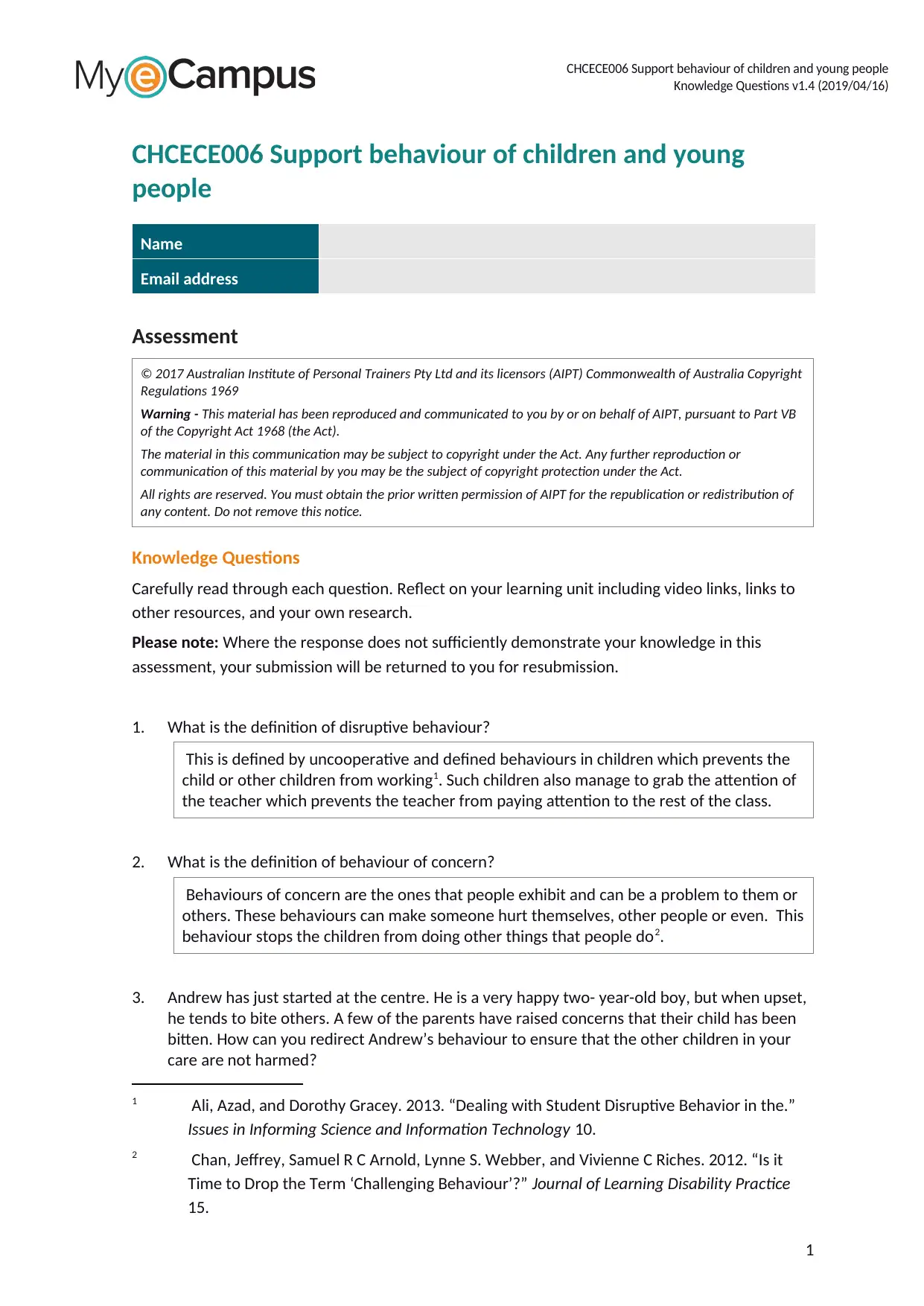
CHCECE006 Support behaviour of children and young people
Knowledge Questions v1.4 (2019/04/16)
CHCECE006 Support behaviour of children and young
people
Name
Email address
Assessment
© 2017 Australian Institute of Personal Trainers Pty Ltd and its licensors (AIPT) Commonwealth of Australia Copyright
Regulations 1969
Warning - This material has been reproduced and communicated to you by or on behalf of AIPT, pursuant to Part VB
of the Copyright Act 1968 (the Act).
The material in this communication may be subject to copyright under the Act. Any further reproduction or
communication of this material by you may be the subject of copyright protection under the Act.
All rights are reserved. You must obtain the prior written permission of AIPT for the republication or redistribution of
any content. Do not remove this notice.
Knowledge Questions
Carefully read through each question. Reflect on your learning unit including video links, links to
other resources, and your own research.
Please note: Where the response does not sufficiently demonstrate your knowledge in this
assessment, your submission will be returned to you for resubmission.
1. What is the definition of disruptive behaviour?
This is defined by uncooperative and defined behaviours in children which prevents the
child or other children from working1. Such children also manage to grab the attention of
the teacher which prevents the teacher from paying attention to the rest of the class.
2. What is the definition of behaviour of concern?
Behaviours of concern are the ones that people exhibit and can be a problem to them or
others. These behaviours can make someone hurt themselves, other people or even. This
behaviour stops the children from doing other things that people do2.
3. Andrew has just started at the centre. He is a very happy two- year-old boy, but when upset,
he tends to bite others. A few of the parents have raised concerns that their child has been
bitten. How can you redirect Andrew’s behaviour to ensure that the other children in your
care are not harmed?
1 Ali, Azad, and Dorothy Gracey. 2013. “Dealing with Student Disruptive Behavior in the.”
Issues in Informing Science and Information Technology 10.
2 Chan, Jeffrey, Samuel R C Arnold, Lynne S. Webber, and Vivienne C Riches. 2012. “Is it
Time to Drop the Term ‘Challenging Behaviour’?” Journal of Learning Disability Practice
15.
1
Knowledge Questions v1.4 (2019/04/16)
CHCECE006 Support behaviour of children and young
people
Name
Email address
Assessment
© 2017 Australian Institute of Personal Trainers Pty Ltd and its licensors (AIPT) Commonwealth of Australia Copyright
Regulations 1969
Warning - This material has been reproduced and communicated to you by or on behalf of AIPT, pursuant to Part VB
of the Copyright Act 1968 (the Act).
The material in this communication may be subject to copyright under the Act. Any further reproduction or
communication of this material by you may be the subject of copyright protection under the Act.
All rights are reserved. You must obtain the prior written permission of AIPT for the republication or redistribution of
any content. Do not remove this notice.
Knowledge Questions
Carefully read through each question. Reflect on your learning unit including video links, links to
other resources, and your own research.
Please note: Where the response does not sufficiently demonstrate your knowledge in this
assessment, your submission will be returned to you for resubmission.
1. What is the definition of disruptive behaviour?
This is defined by uncooperative and defined behaviours in children which prevents the
child or other children from working1. Such children also manage to grab the attention of
the teacher which prevents the teacher from paying attention to the rest of the class.
2. What is the definition of behaviour of concern?
Behaviours of concern are the ones that people exhibit and can be a problem to them or
others. These behaviours can make someone hurt themselves, other people or even. This
behaviour stops the children from doing other things that people do2.
3. Andrew has just started at the centre. He is a very happy two- year-old boy, but when upset,
he tends to bite others. A few of the parents have raised concerns that their child has been
bitten. How can you redirect Andrew’s behaviour to ensure that the other children in your
care are not harmed?
1 Ali, Azad, and Dorothy Gracey. 2013. “Dealing with Student Disruptive Behavior in the.”
Issues in Informing Science and Information Technology 10.
2 Chan, Jeffrey, Samuel R C Arnold, Lynne S. Webber, and Vivienne C Riches. 2012. “Is it
Time to Drop the Term ‘Challenging Behaviour’?” Journal of Learning Disability Practice
15.
1
Secure Best Marks with AI Grader
Need help grading? Try our AI Grader for instant feedback on your assignments.
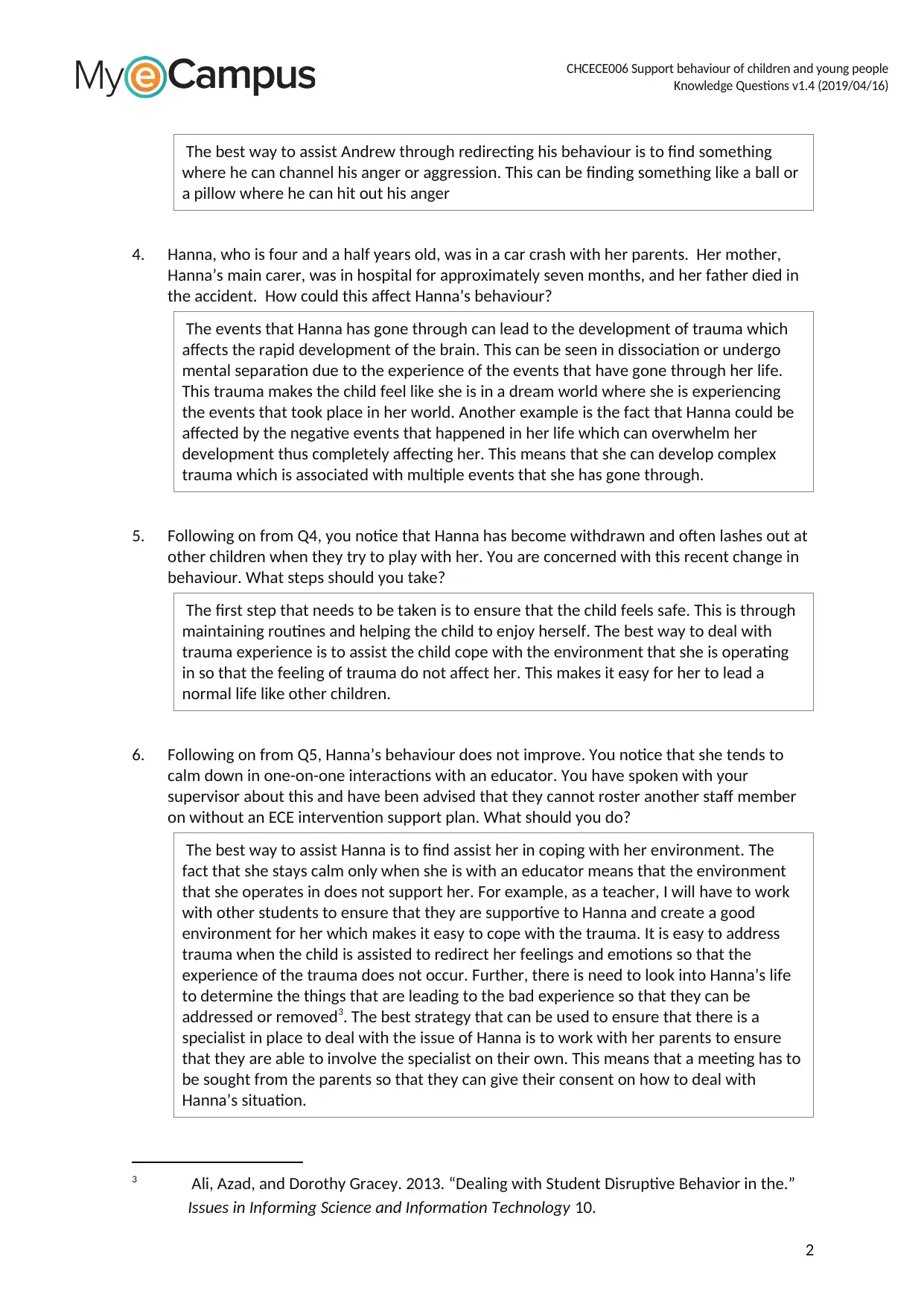
CHCECE006 Support behaviour of children and young people
Knowledge Questions v1.4 (2019/04/16)
The best way to assist Andrew through redirecting his behaviour is to find something
where he can channel his anger or aggression. This can be finding something like a ball or
a pillow where he can hit out his anger
4. Hanna, who is four and a half years old, was in a car crash with her parents. Her mother,
Hanna’s main carer, was in hospital for approximately seven months, and her father died in
the accident. How could this affect Hanna’s behaviour?
The events that Hanna has gone through can lead to the development of trauma which
affects the rapid development of the brain. This can be seen in dissociation or undergo
mental separation due to the experience of the events that have gone through her life.
This trauma makes the child feel like she is in a dream world where she is experiencing
the events that took place in her world. Another example is the fact that Hanna could be
affected by the negative events that happened in her life which can overwhelm her
development thus completely affecting her. This means that she can develop complex
trauma which is associated with multiple events that she has gone through.
5. Following on from Q4, you notice that Hanna has become withdrawn and often lashes out at
other children when they try to play with her. You are concerned with this recent change in
behaviour. What steps should you take?
The first step that needs to be taken is to ensure that the child feels safe. This is through
maintaining routines and helping the child to enjoy herself. The best way to deal with
trauma experience is to assist the child cope with the environment that she is operating
in so that the feeling of trauma do not affect her. This makes it easy for her to lead a
normal life like other children.
6. Following on from Q5, Hanna’s behaviour does not improve. You notice that she tends to
calm down in one-on-one interactions with an educator. You have spoken with your
supervisor about this and have been advised that they cannot roster another staff member
on without an ECE intervention support plan. What should you do?
The best way to assist Hanna is to find assist her in coping with her environment. The
fact that she stays calm only when she is with an educator means that the environment
that she operates in does not support her. For example, as a teacher, I will have to work
with other students to ensure that they are supportive to Hanna and create a good
environment for her which makes it easy to cope with the trauma. It is easy to address
trauma when the child is assisted to redirect her feelings and emotions so that the
experience of the trauma does not occur. Further, there is need to look into Hanna’s life
to determine the things that are leading to the bad experience so that they can be
addressed or removed3. The best strategy that can be used to ensure that there is a
specialist in place to deal with the issue of Hanna is to work with her parents to ensure
that they are able to involve the specialist on their own. This means that a meeting has to
be sought from the parents so that they can give their consent on how to deal with
Hanna’s situation.
3 Ali, Azad, and Dorothy Gracey. 2013. “Dealing with Student Disruptive Behavior in the.”
Issues in Informing Science and Information Technology 10.
2
Knowledge Questions v1.4 (2019/04/16)
The best way to assist Andrew through redirecting his behaviour is to find something
where he can channel his anger or aggression. This can be finding something like a ball or
a pillow where he can hit out his anger
4. Hanna, who is four and a half years old, was in a car crash with her parents. Her mother,
Hanna’s main carer, was in hospital for approximately seven months, and her father died in
the accident. How could this affect Hanna’s behaviour?
The events that Hanna has gone through can lead to the development of trauma which
affects the rapid development of the brain. This can be seen in dissociation or undergo
mental separation due to the experience of the events that have gone through her life.
This trauma makes the child feel like she is in a dream world where she is experiencing
the events that took place in her world. Another example is the fact that Hanna could be
affected by the negative events that happened in her life which can overwhelm her
development thus completely affecting her. This means that she can develop complex
trauma which is associated with multiple events that she has gone through.
5. Following on from Q4, you notice that Hanna has become withdrawn and often lashes out at
other children when they try to play with her. You are concerned with this recent change in
behaviour. What steps should you take?
The first step that needs to be taken is to ensure that the child feels safe. This is through
maintaining routines and helping the child to enjoy herself. The best way to deal with
trauma experience is to assist the child cope with the environment that she is operating
in so that the feeling of trauma do not affect her. This makes it easy for her to lead a
normal life like other children.
6. Following on from Q5, Hanna’s behaviour does not improve. You notice that she tends to
calm down in one-on-one interactions with an educator. You have spoken with your
supervisor about this and have been advised that they cannot roster another staff member
on without an ECE intervention support plan. What should you do?
The best way to assist Hanna is to find assist her in coping with her environment. The
fact that she stays calm only when she is with an educator means that the environment
that she operates in does not support her. For example, as a teacher, I will have to work
with other students to ensure that they are supportive to Hanna and create a good
environment for her which makes it easy to cope with the trauma. It is easy to address
trauma when the child is assisted to redirect her feelings and emotions so that the
experience of the trauma does not occur. Further, there is need to look into Hanna’s life
to determine the things that are leading to the bad experience so that they can be
addressed or removed3. The best strategy that can be used to ensure that there is a
specialist in place to deal with the issue of Hanna is to work with her parents to ensure
that they are able to involve the specialist on their own. This means that a meeting has to
be sought from the parents so that they can give their consent on how to deal with
Hanna’s situation.
3 Ali, Azad, and Dorothy Gracey. 2013. “Dealing with Student Disruptive Behavior in the.”
Issues in Informing Science and Information Technology 10.
2
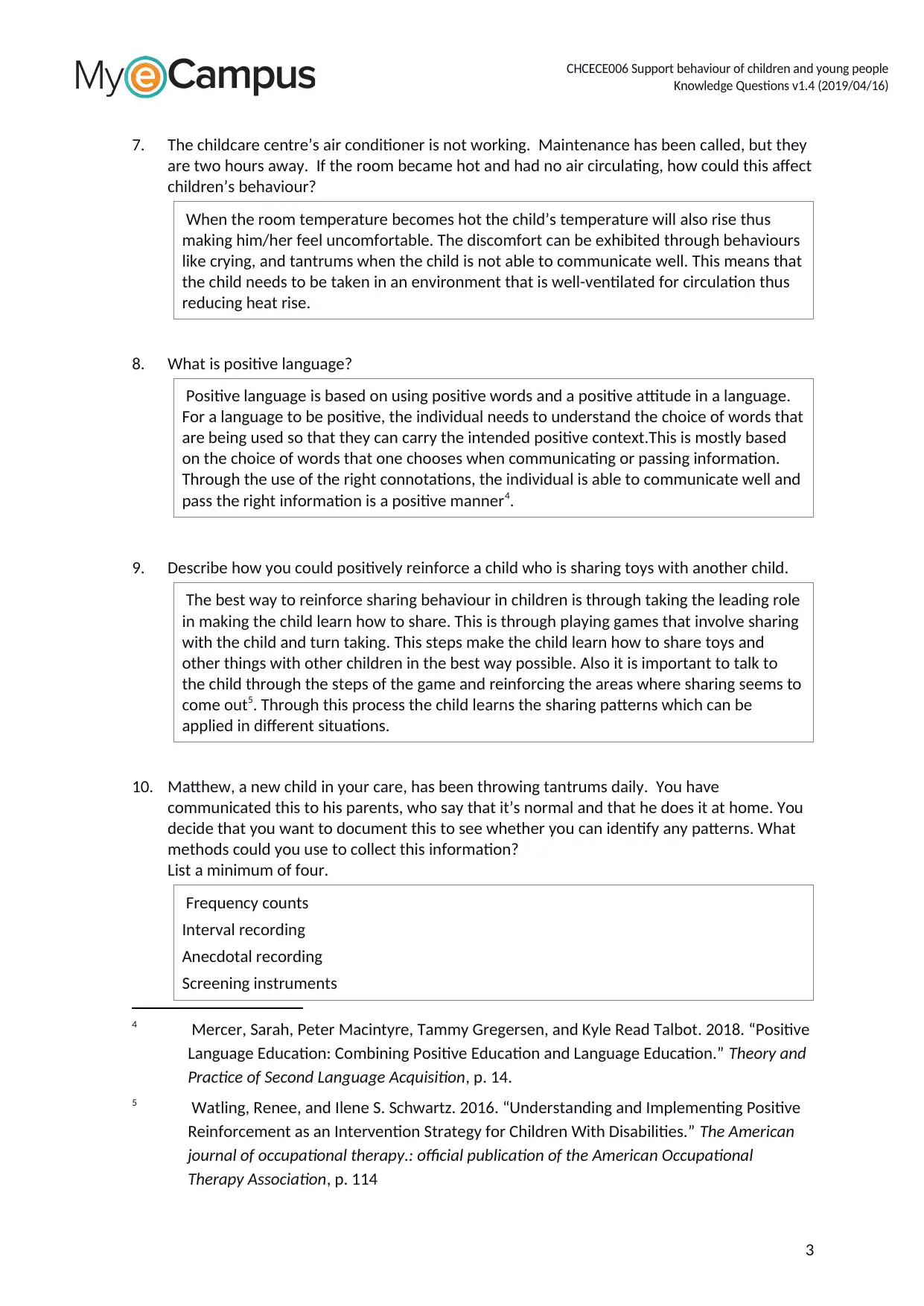
CHCECE006 Support behaviour of children and young people
Knowledge Questions v1.4 (2019/04/16)
7. The childcare centre’s air conditioner is not working. Maintenance has been called, but they
are two hours away. If the room became hot and had no air circulating, how could this affect
children’s behaviour?
When the room temperature becomes hot the child’s temperature will also rise thus
making him/her feel uncomfortable. The discomfort can be exhibited through behaviours
like crying, and tantrums when the child is not able to communicate well. This means that
the child needs to be taken in an environment that is well-ventilated for circulation thus
reducing heat rise.
8. What is positive language?
Positive language is based on using positive words and a positive attitude in a language.
For a language to be positive, the individual needs to understand the choice of words that
are being used so that they can carry the intended positive context.This is mostly based
on the choice of words that one chooses when communicating or passing information.
Through the use of the right connotations, the individual is able to communicate well and
pass the right information is a positive manner4.
9. Describe how you could positively reinforce a child who is sharing toys with another child.
The best way to reinforce sharing behaviour in children is through taking the leading role
in making the child learn how to share. This is through playing games that involve sharing
with the child and turn taking. This steps make the child learn how to share toys and
other things with other children in the best way possible. Also it is important to talk to
the child through the steps of the game and reinforcing the areas where sharing seems to
come out5. Through this process the child learns the sharing patterns which can be
applied in different situations.
10. Matthew, a new child in your care, has been throwing tantrums daily. You have
communicated this to his parents, who say that it’s normal and that he does it at home. You
decide that you want to document this to see whether you can identify any patterns. What
methods could you use to collect this information?
List a minimum of four.
Frequency counts
Interval recording
Anecdotal recording
Screening instruments
4 Mercer, Sarah, Peter Macintyre, Tammy Gregersen, and Kyle Read Talbot. 2018. “Positive
Language Education: Combining Positive Education and Language Education.” Theory and
Practice of Second Language Acquisition, p. 14.
5 Watling, Renee, and Ilene S. Schwartz. 2016. “Understanding and Implementing Positive
Reinforcement as an Intervention Strategy for Children With Disabilities.” The American
journal of occupational therapy.: official publication of the American Occupational
Therapy Association, p. 114
3
Knowledge Questions v1.4 (2019/04/16)
7. The childcare centre’s air conditioner is not working. Maintenance has been called, but they
are two hours away. If the room became hot and had no air circulating, how could this affect
children’s behaviour?
When the room temperature becomes hot the child’s temperature will also rise thus
making him/her feel uncomfortable. The discomfort can be exhibited through behaviours
like crying, and tantrums when the child is not able to communicate well. This means that
the child needs to be taken in an environment that is well-ventilated for circulation thus
reducing heat rise.
8. What is positive language?
Positive language is based on using positive words and a positive attitude in a language.
For a language to be positive, the individual needs to understand the choice of words that
are being used so that they can carry the intended positive context.This is mostly based
on the choice of words that one chooses when communicating or passing information.
Through the use of the right connotations, the individual is able to communicate well and
pass the right information is a positive manner4.
9. Describe how you could positively reinforce a child who is sharing toys with another child.
The best way to reinforce sharing behaviour in children is through taking the leading role
in making the child learn how to share. This is through playing games that involve sharing
with the child and turn taking. This steps make the child learn how to share toys and
other things with other children in the best way possible. Also it is important to talk to
the child through the steps of the game and reinforcing the areas where sharing seems to
come out5. Through this process the child learns the sharing patterns which can be
applied in different situations.
10. Matthew, a new child in your care, has been throwing tantrums daily. You have
communicated this to his parents, who say that it’s normal and that he does it at home. You
decide that you want to document this to see whether you can identify any patterns. What
methods could you use to collect this information?
List a minimum of four.
Frequency counts
Interval recording
Anecdotal recording
Screening instruments
4 Mercer, Sarah, Peter Macintyre, Tammy Gregersen, and Kyle Read Talbot. 2018. “Positive
Language Education: Combining Positive Education and Language Education.” Theory and
Practice of Second Language Acquisition, p. 14.
5 Watling, Renee, and Ilene S. Schwartz. 2016. “Understanding and Implementing Positive
Reinforcement as an Intervention Strategy for Children With Disabilities.” The American
journal of occupational therapy.: official publication of the American Occupational
Therapy Association, p. 114
3
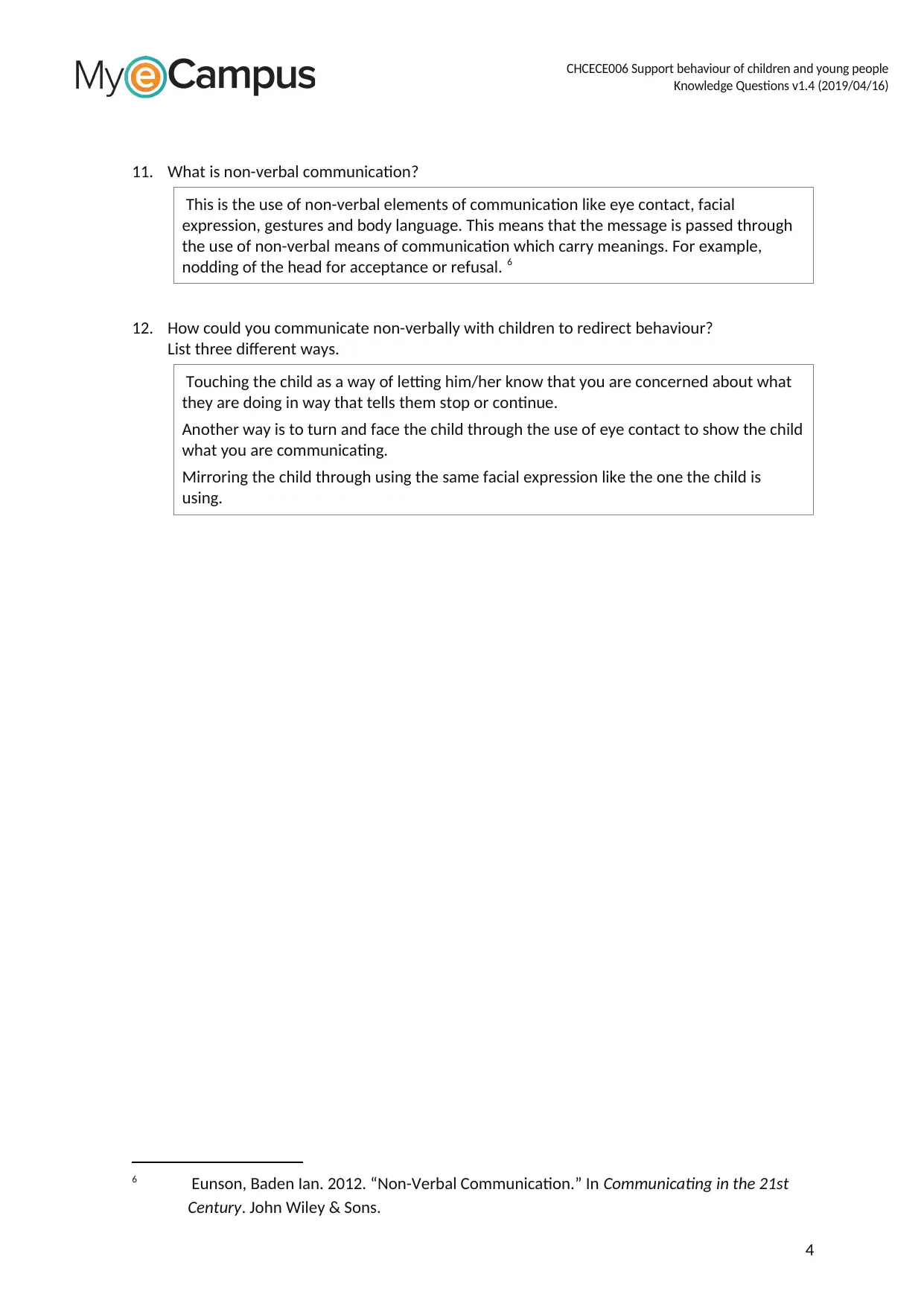
CHCECE006 Support behaviour of children and young people
Knowledge Questions v1.4 (2019/04/16)
11. What is non-verbal communication?
This is the use of non-verbal elements of communication like eye contact, facial
expression, gestures and body language. This means that the message is passed through
the use of non-verbal means of communication which carry meanings. For example,
nodding of the head for acceptance or refusal. 6
12. How could you communicate non-verbally with children to redirect behaviour?
List three different ways.
Touching the child as a way of letting him/her know that you are concerned about what
they are doing in way that tells them stop or continue.
Another way is to turn and face the child through the use of eye contact to show the child
what you are communicating.
Mirroring the child through using the same facial expression like the one the child is
using.
6 Eunson, Baden Ian. 2012. “Non-Verbal Communication.” In Communicating in the 21st
Century. John Wiley & Sons.
4
Knowledge Questions v1.4 (2019/04/16)
11. What is non-verbal communication?
This is the use of non-verbal elements of communication like eye contact, facial
expression, gestures and body language. This means that the message is passed through
the use of non-verbal means of communication which carry meanings. For example,
nodding of the head for acceptance or refusal. 6
12. How could you communicate non-verbally with children to redirect behaviour?
List three different ways.
Touching the child as a way of letting him/her know that you are concerned about what
they are doing in way that tells them stop or continue.
Another way is to turn and face the child through the use of eye contact to show the child
what you are communicating.
Mirroring the child through using the same facial expression like the one the child is
using.
6 Eunson, Baden Ian. 2012. “Non-Verbal Communication.” In Communicating in the 21st
Century. John Wiley & Sons.
4
Secure Best Marks with AI Grader
Need help grading? Try our AI Grader for instant feedback on your assignments.
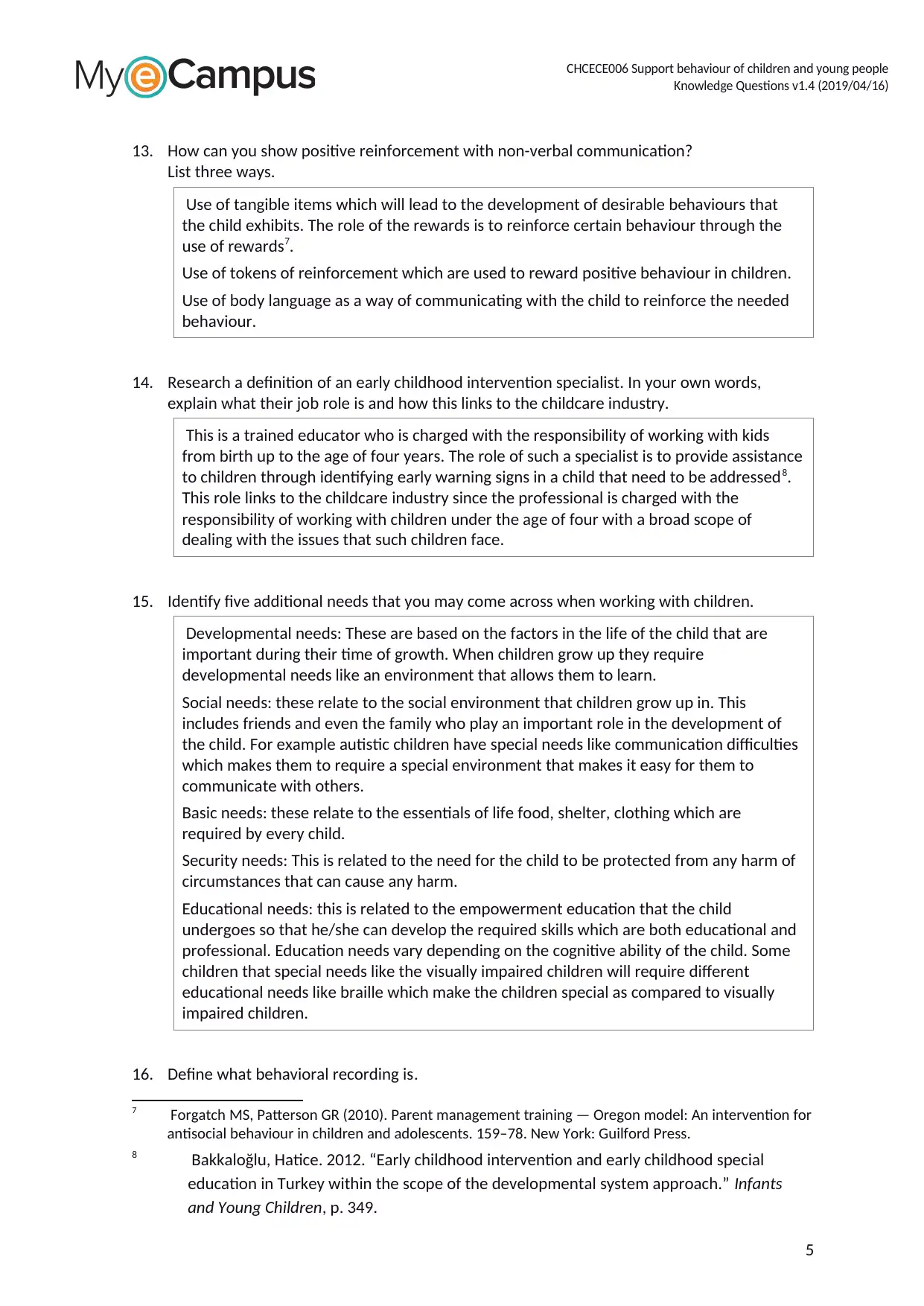
CHCECE006 Support behaviour of children and young people
Knowledge Questions v1.4 (2019/04/16)
13. How can you show positive reinforcement with non-verbal communication?
List three ways.
Use of tangible items which will lead to the development of desirable behaviours that
the child exhibits. The role of the rewards is to reinforce certain behaviour through the
use of rewards7.
Use of tokens of reinforcement which are used to reward positive behaviour in children.
Use of body language as a way of communicating with the child to reinforce the needed
behaviour.
14. Research a definition of an early childhood intervention specialist. In your own words,
explain what their job role is and how this links to the childcare industry.
This is a trained educator who is charged with the responsibility of working with kids
from birth up to the age of four years. The role of such a specialist is to provide assistance
to children through identifying early warning signs in a child that need to be addressed8.
This role links to the childcare industry since the professional is charged with the
responsibility of working with children under the age of four with a broad scope of
dealing with the issues that such children face.
15. Identify five additional needs that you may come across when working with children.
Developmental needs: These are based on the factors in the life of the child that are
important during their time of growth. When children grow up they require
developmental needs like an environment that allows them to learn.
Social needs: these relate to the social environment that children grow up in. This
includes friends and even the family who play an important role in the development of
the child. For example autistic children have special needs like communication difficulties
which makes them to require a special environment that makes it easy for them to
communicate with others.
Basic needs: these relate to the essentials of life food, shelter, clothing which are
required by every child.
Security needs: This is related to the need for the child to be protected from any harm of
circumstances that can cause any harm.
Educational needs: this is related to the empowerment education that the child
undergoes so that he/she can develop the required skills which are both educational and
professional. Education needs vary depending on the cognitive ability of the child. Some
children that special needs like the visually impaired children will require different
educational needs like braille which make the children special as compared to visually
impaired children.
16. Define what behavioral recording is.
7 Forgatch MS, Patterson GR (2010). Parent management training — Oregon model: An intervention for
antisocial behaviour in children and adolescents. 159–78. New York: Guilford Press.
8 Bakkaloğlu, Hatice. 2012. “Early childhood intervention and early childhood special
education in Turkey within the scope of the developmental system approach.” Infants
and Young Children, p. 349.
5
Knowledge Questions v1.4 (2019/04/16)
13. How can you show positive reinforcement with non-verbal communication?
List three ways.
Use of tangible items which will lead to the development of desirable behaviours that
the child exhibits. The role of the rewards is to reinforce certain behaviour through the
use of rewards7.
Use of tokens of reinforcement which are used to reward positive behaviour in children.
Use of body language as a way of communicating with the child to reinforce the needed
behaviour.
14. Research a definition of an early childhood intervention specialist. In your own words,
explain what their job role is and how this links to the childcare industry.
This is a trained educator who is charged with the responsibility of working with kids
from birth up to the age of four years. The role of such a specialist is to provide assistance
to children through identifying early warning signs in a child that need to be addressed8.
This role links to the childcare industry since the professional is charged with the
responsibility of working with children under the age of four with a broad scope of
dealing with the issues that such children face.
15. Identify five additional needs that you may come across when working with children.
Developmental needs: These are based on the factors in the life of the child that are
important during their time of growth. When children grow up they require
developmental needs like an environment that allows them to learn.
Social needs: these relate to the social environment that children grow up in. This
includes friends and even the family who play an important role in the development of
the child. For example autistic children have special needs like communication difficulties
which makes them to require a special environment that makes it easy for them to
communicate with others.
Basic needs: these relate to the essentials of life food, shelter, clothing which are
required by every child.
Security needs: This is related to the need for the child to be protected from any harm of
circumstances that can cause any harm.
Educational needs: this is related to the empowerment education that the child
undergoes so that he/she can develop the required skills which are both educational and
professional. Education needs vary depending on the cognitive ability of the child. Some
children that special needs like the visually impaired children will require different
educational needs like braille which make the children special as compared to visually
impaired children.
16. Define what behavioral recording is.
7 Forgatch MS, Patterson GR (2010). Parent management training — Oregon model: An intervention for
antisocial behaviour in children and adolescents. 159–78. New York: Guilford Press.
8 Bakkaloğlu, Hatice. 2012. “Early childhood intervention and early childhood special
education in Turkey within the scope of the developmental system approach.” Infants
and Young Children, p. 349.
5
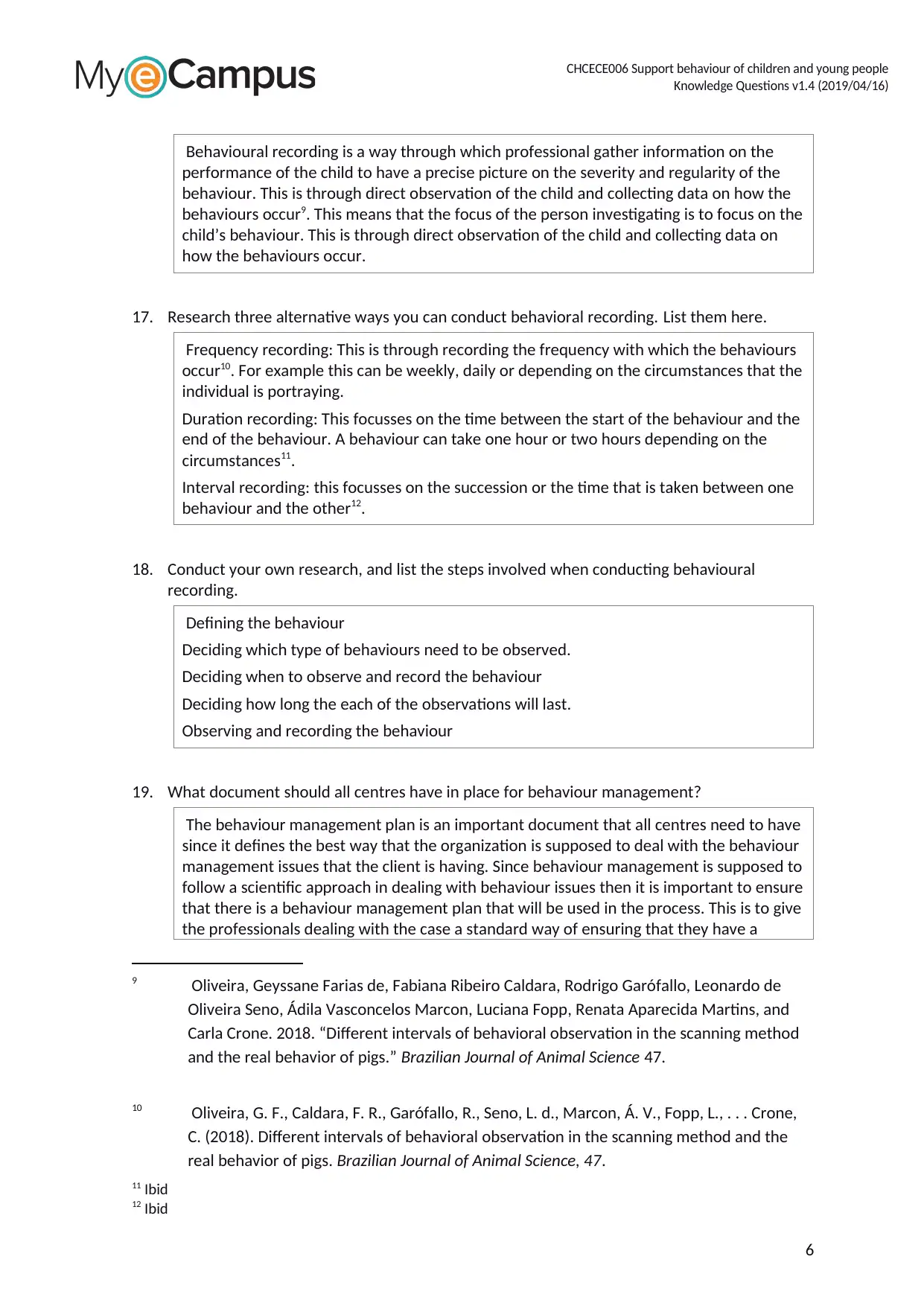
CHCECE006 Support behaviour of children and young people
Knowledge Questions v1.4 (2019/04/16)
Behavioural recording is a way through which professional gather information on the
performance of the child to have a precise picture on the severity and regularity of the
behaviour. This is through direct observation of the child and collecting data on how the
behaviours occur9. This means that the focus of the person investigating is to focus on the
child’s behaviour. This is through direct observation of the child and collecting data on
how the behaviours occur.
17. Research three alternative ways you can conduct behavioral recording. List them here.
Frequency recording: This is through recording the frequency with which the behaviours
occur10. For example this can be weekly, daily or depending on the circumstances that the
individual is portraying.
Duration recording: This focusses on the time between the start of the behaviour and the
end of the behaviour. A behaviour can take one hour or two hours depending on the
circumstances11.
Interval recording: this focusses on the succession or the time that is taken between one
behaviour and the other12.
18. Conduct your own research, and list the steps involved when conducting behavioural
recording.
Defining the behaviour
Deciding which type of behaviours need to be observed.
Deciding when to observe and record the behaviour
Deciding how long the each of the observations will last.
Observing and recording the behaviour
19. What document should all centres have in place for behaviour management?
The behaviour management plan is an important document that all centres need to have
since it defines the best way that the organization is supposed to deal with the behaviour
management issues that the client is having. Since behaviour management is supposed to
follow a scientific approach in dealing with behaviour issues then it is important to ensure
that there is a behaviour management plan that will be used in the process. This is to give
the professionals dealing with the case a standard way of ensuring that they have a
9 Oliveira, Geyssane Farias de, Fabiana Ribeiro Caldara, Rodrigo Garófallo, Leonardo de
Oliveira Seno, Ádila Vasconcelos Marcon, Luciana Fopp, Renata Aparecida Martins, and
Carla Crone. 2018. “Different intervals of behavioral observation in the scanning method
and the real behavior of pigs.” Brazilian Journal of Animal Science 47.
10 Oliveira, G. F., Caldara, F. R., Garófallo, R., Seno, L. d., Marcon, Á. V., Fopp, L., . . . Crone,
C. (2018). Different intervals of behavioral observation in the scanning method and the
real behavior of pigs. Brazilian Journal of Animal Science, 47.
11 Ibid
12 Ibid
6
Knowledge Questions v1.4 (2019/04/16)
Behavioural recording is a way through which professional gather information on the
performance of the child to have a precise picture on the severity and regularity of the
behaviour. This is through direct observation of the child and collecting data on how the
behaviours occur9. This means that the focus of the person investigating is to focus on the
child’s behaviour. This is through direct observation of the child and collecting data on
how the behaviours occur.
17. Research three alternative ways you can conduct behavioral recording. List them here.
Frequency recording: This is through recording the frequency with which the behaviours
occur10. For example this can be weekly, daily or depending on the circumstances that the
individual is portraying.
Duration recording: This focusses on the time between the start of the behaviour and the
end of the behaviour. A behaviour can take one hour or two hours depending on the
circumstances11.
Interval recording: this focusses on the succession or the time that is taken between one
behaviour and the other12.
18. Conduct your own research, and list the steps involved when conducting behavioural
recording.
Defining the behaviour
Deciding which type of behaviours need to be observed.
Deciding when to observe and record the behaviour
Deciding how long the each of the observations will last.
Observing and recording the behaviour
19. What document should all centres have in place for behaviour management?
The behaviour management plan is an important document that all centres need to have
since it defines the best way that the organization is supposed to deal with the behaviour
management issues that the client is having. Since behaviour management is supposed to
follow a scientific approach in dealing with behaviour issues then it is important to ensure
that there is a behaviour management plan that will be used in the process. This is to give
the professionals dealing with the case a standard way of ensuring that they have a
9 Oliveira, Geyssane Farias de, Fabiana Ribeiro Caldara, Rodrigo Garófallo, Leonardo de
Oliveira Seno, Ádila Vasconcelos Marcon, Luciana Fopp, Renata Aparecida Martins, and
Carla Crone. 2018. “Different intervals of behavioral observation in the scanning method
and the real behavior of pigs.” Brazilian Journal of Animal Science 47.
10 Oliveira, G. F., Caldara, F. R., Garófallo, R., Seno, L. d., Marcon, Á. V., Fopp, L., . . . Crone,
C. (2018). Different intervals of behavioral observation in the scanning method and the
real behavior of pigs. Brazilian Journal of Animal Science, 47.
11 Ibid
12 Ibid
6
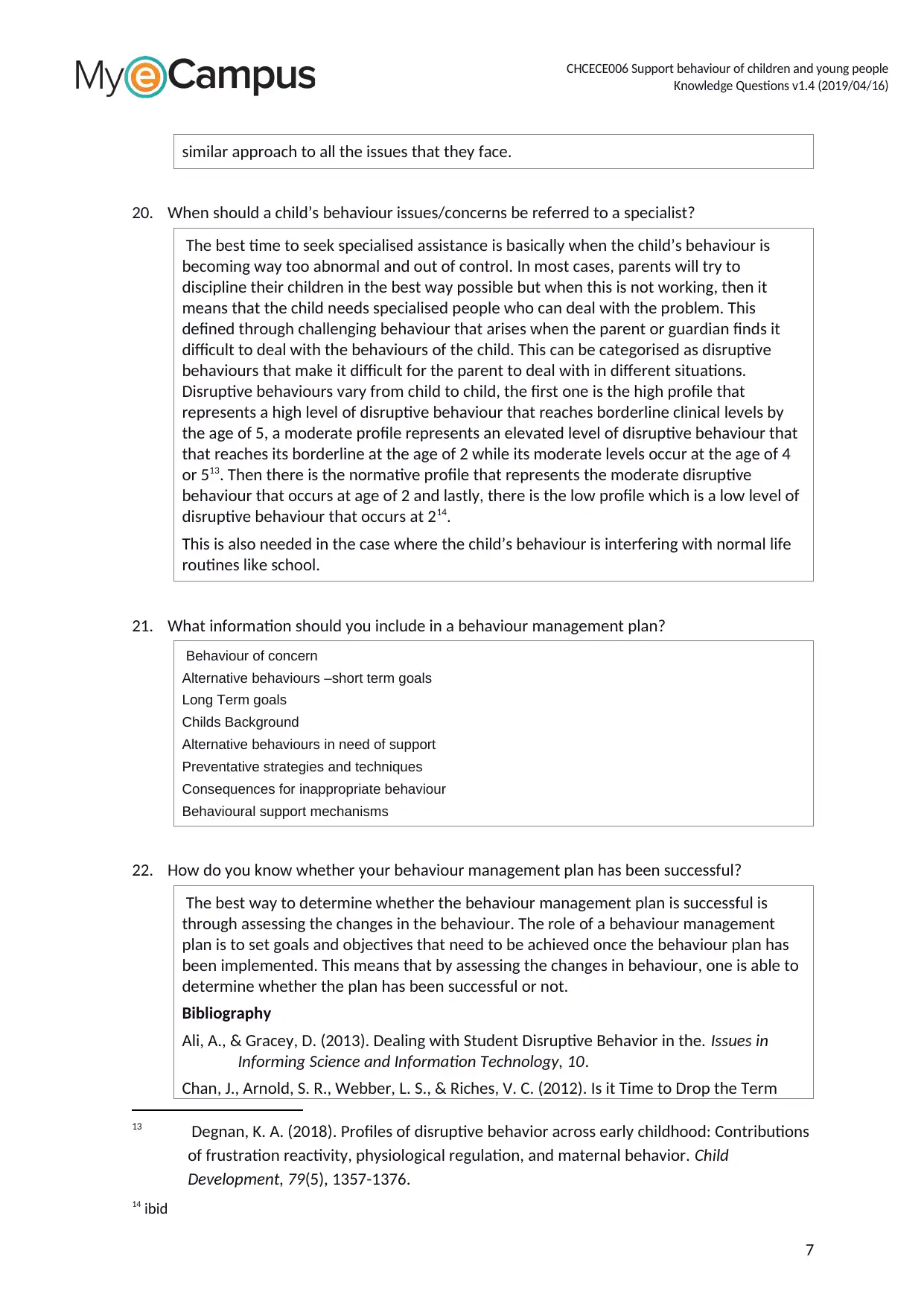
CHCECE006 Support behaviour of children and young people
Knowledge Questions v1.4 (2019/04/16)
similar approach to all the issues that they face.
20. When should a child’s behaviour issues/concerns be referred to a specialist?
The best time to seek specialised assistance is basically when the child’s behaviour is
becoming way too abnormal and out of control. In most cases, parents will try to
discipline their children in the best way possible but when this is not working, then it
means that the child needs specialised people who can deal with the problem. This
defined through challenging behaviour that arises when the parent or guardian finds it
difficult to deal with the behaviours of the child. This can be categorised as disruptive
behaviours that make it difficult for the parent to deal with in different situations.
Disruptive behaviours vary from child to child, the first one is the high profile that
represents a high level of disruptive behaviour that reaches borderline clinical levels by
the age of 5, a moderate profile represents an elevated level of disruptive behaviour that
that reaches its borderline at the age of 2 while its moderate levels occur at the age of 4
or 513. Then there is the normative profile that represents the moderate disruptive
behaviour that occurs at age of 2 and lastly, there is the low profile which is a low level of
disruptive behaviour that occurs at 214.
This is also needed in the case where the child’s behaviour is interfering with normal life
routines like school.
21. What information should you include in a behaviour management plan?
Behaviour of concern
Alternative behaviours –short term goals
Long Term goals
Childs Background
Alternative behaviours in need of support
Preventative strategies and techniques
Consequences for inappropriate behaviour
Behavioural support mechanisms
22. How do you know whether your behaviour management plan has been successful?
The best way to determine whether the behaviour management plan is successful is
through assessing the changes in the behaviour. The role of a behaviour management
plan is to set goals and objectives that need to be achieved once the behaviour plan has
been implemented. This means that by assessing the changes in behaviour, one is able to
determine whether the plan has been successful or not.
Bibliography
Ali, A., & Gracey, D. (2013). Dealing with Student Disruptive Behavior in the. Issues in
Informing Science and Information Technology, 10.
Chan, J., Arnold, S. R., Webber, L. S., & Riches, V. C. (2012). Is it Time to Drop the Term
13 Degnan, K. A. (2018). Profiles of disruptive behavior across early childhood: Contributions
of frustration reactivity, physiological regulation, and maternal behavior. Child
Development, 79(5), 1357-1376.
14 ibid
7
Knowledge Questions v1.4 (2019/04/16)
similar approach to all the issues that they face.
20. When should a child’s behaviour issues/concerns be referred to a specialist?
The best time to seek specialised assistance is basically when the child’s behaviour is
becoming way too abnormal and out of control. In most cases, parents will try to
discipline their children in the best way possible but when this is not working, then it
means that the child needs specialised people who can deal with the problem. This
defined through challenging behaviour that arises when the parent or guardian finds it
difficult to deal with the behaviours of the child. This can be categorised as disruptive
behaviours that make it difficult for the parent to deal with in different situations.
Disruptive behaviours vary from child to child, the first one is the high profile that
represents a high level of disruptive behaviour that reaches borderline clinical levels by
the age of 5, a moderate profile represents an elevated level of disruptive behaviour that
that reaches its borderline at the age of 2 while its moderate levels occur at the age of 4
or 513. Then there is the normative profile that represents the moderate disruptive
behaviour that occurs at age of 2 and lastly, there is the low profile which is a low level of
disruptive behaviour that occurs at 214.
This is also needed in the case where the child’s behaviour is interfering with normal life
routines like school.
21. What information should you include in a behaviour management plan?
Behaviour of concern
Alternative behaviours –short term goals
Long Term goals
Childs Background
Alternative behaviours in need of support
Preventative strategies and techniques
Consequences for inappropriate behaviour
Behavioural support mechanisms
22. How do you know whether your behaviour management plan has been successful?
The best way to determine whether the behaviour management plan is successful is
through assessing the changes in the behaviour. The role of a behaviour management
plan is to set goals and objectives that need to be achieved once the behaviour plan has
been implemented. This means that by assessing the changes in behaviour, one is able to
determine whether the plan has been successful or not.
Bibliography
Ali, A., & Gracey, D. (2013). Dealing with Student Disruptive Behavior in the. Issues in
Informing Science and Information Technology, 10.
Chan, J., Arnold, S. R., Webber, L. S., & Riches, V. C. (2012). Is it Time to Drop the Term
13 Degnan, K. A. (2018). Profiles of disruptive behavior across early childhood: Contributions
of frustration reactivity, physiological regulation, and maternal behavior. Child
Development, 79(5), 1357-1376.
14 ibid
7
Paraphrase This Document
Need a fresh take? Get an instant paraphrase of this document with our AI Paraphraser
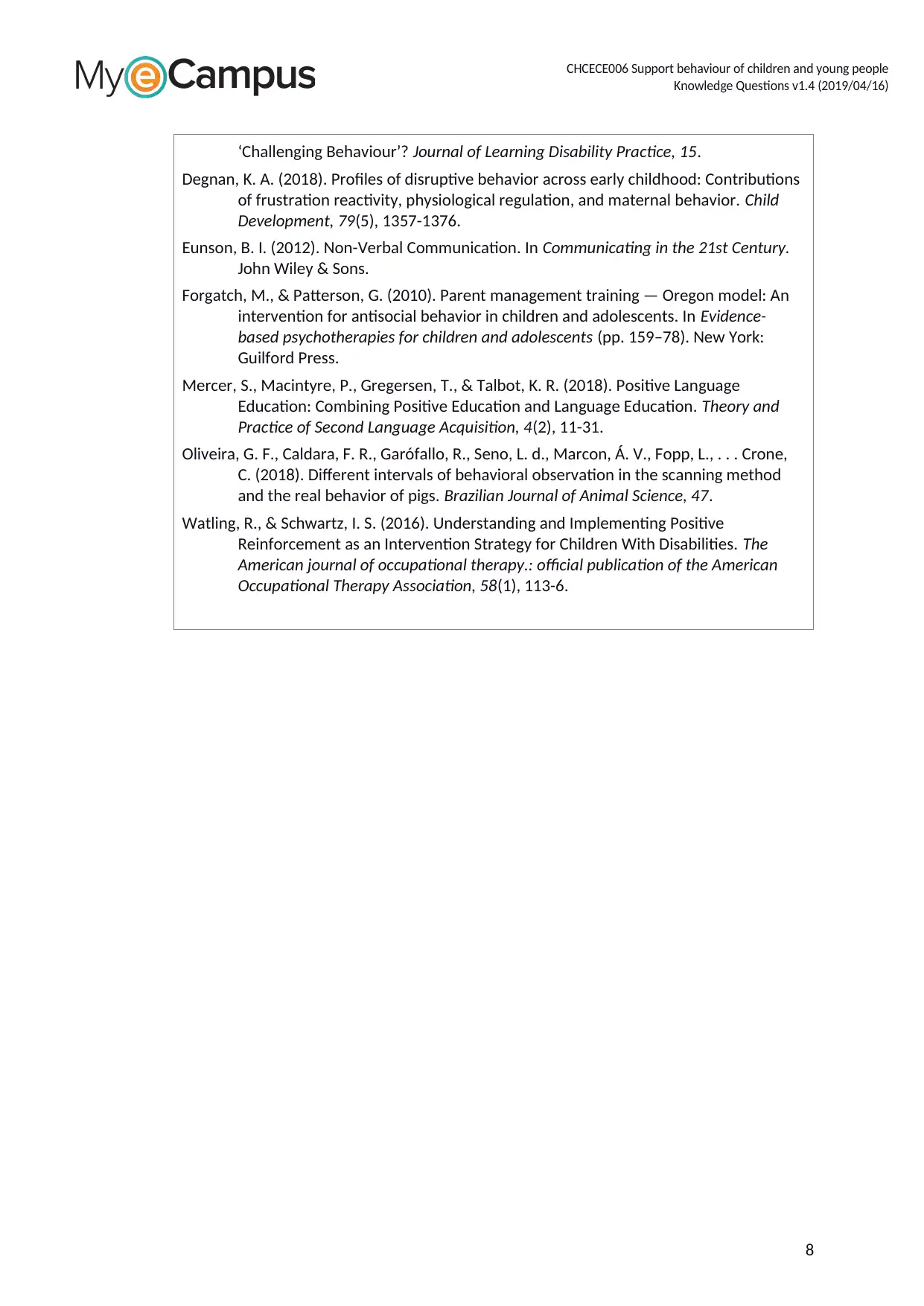
CHCECE006 Support behaviour of children and young people
Knowledge Questions v1.4 (2019/04/16)
‘Challenging Behaviour’? Journal of Learning Disability Practice, 15.
Degnan, K. A. (2018). Profiles of disruptive behavior across early childhood: Contributions
of frustration reactivity, physiological regulation, and maternal behavior. Child
Development, 79(5), 1357-1376.
Eunson, B. I. (2012). Non-Verbal Communication. In Communicating in the 21st Century.
John Wiley & Sons.
Forgatch, M., & Patterson, G. (2010). Parent management training — Oregon model: An
intervention for antisocial behavior in children and adolescents. In Evidence-
based psychotherapies for children and adolescents (pp. 159–78). New York:
Guilford Press.
Mercer, S., Macintyre, P., Gregersen, T., & Talbot, K. R. (2018). Positive Language
Education: Combining Positive Education and Language Education. Theory and
Practice of Second Language Acquisition, 4(2), 11-31.
Oliveira, G. F., Caldara, F. R., Garófallo, R., Seno, L. d., Marcon, Á. V., Fopp, L., . . . Crone,
C. (2018). Different intervals of behavioral observation in the scanning method
and the real behavior of pigs. Brazilian Journal of Animal Science, 47.
Watling, R., & Schwartz, I. S. (2016). Understanding and Implementing Positive
Reinforcement as an Intervention Strategy for Children With Disabilities. The
American journal of occupational therapy.: official publication of the American
Occupational Therapy Association, 58(1), 113-6.
8
Knowledge Questions v1.4 (2019/04/16)
‘Challenging Behaviour’? Journal of Learning Disability Practice, 15.
Degnan, K. A. (2018). Profiles of disruptive behavior across early childhood: Contributions
of frustration reactivity, physiological regulation, and maternal behavior. Child
Development, 79(5), 1357-1376.
Eunson, B. I. (2012). Non-Verbal Communication. In Communicating in the 21st Century.
John Wiley & Sons.
Forgatch, M., & Patterson, G. (2010). Parent management training — Oregon model: An
intervention for antisocial behavior in children and adolescents. In Evidence-
based psychotherapies for children and adolescents (pp. 159–78). New York:
Guilford Press.
Mercer, S., Macintyre, P., Gregersen, T., & Talbot, K. R. (2018). Positive Language
Education: Combining Positive Education and Language Education. Theory and
Practice of Second Language Acquisition, 4(2), 11-31.
Oliveira, G. F., Caldara, F. R., Garófallo, R., Seno, L. d., Marcon, Á. V., Fopp, L., . . . Crone,
C. (2018). Different intervals of behavioral observation in the scanning method
and the real behavior of pigs. Brazilian Journal of Animal Science, 47.
Watling, R., & Schwartz, I. S. (2016). Understanding and Implementing Positive
Reinforcement as an Intervention Strategy for Children With Disabilities. The
American journal of occupational therapy.: official publication of the American
Occupational Therapy Association, 58(1), 113-6.
8
1 out of 8
Related Documents
Your All-in-One AI-Powered Toolkit for Academic Success.
+13062052269
info@desklib.com
Available 24*7 on WhatsApp / Email
![[object Object]](/_next/static/media/star-bottom.7253800d.svg)
Unlock your academic potential
© 2024 | Zucol Services PVT LTD | All rights reserved.





